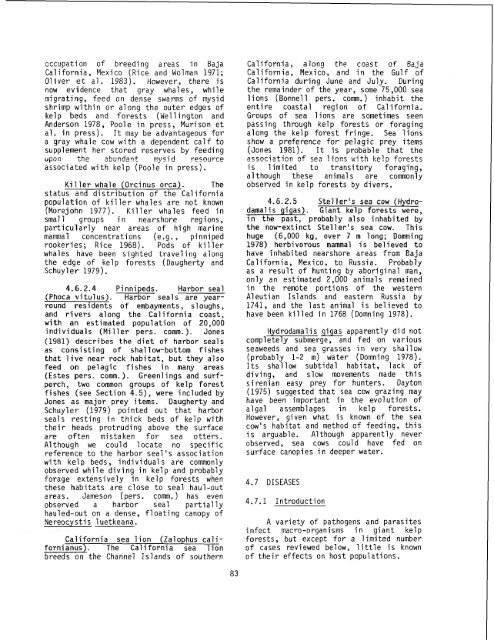The ecology of giant kelp forests in California - USGS National ...
The ecology of giant kelp forests in California - USGS National ...
The ecology of giant kelp forests in California - USGS National ...
- No tags were found...
Create successful ePaper yourself
Turn your PDF publications into a flip-book with our unique Google optimized e-Paper software.
occupation <strong>of</strong> breed<strong>in</strong>g areas <strong>in</strong> Baja<br />
<strong>California</strong>, Mexico (Rice and Wolman 1971;<br />
Oliver et al. 1983). However, there is<br />
now evidence that gray whales, while<br />
migrat<strong>in</strong>g, feed on dense swarms <strong>of</strong> mysid<br />
shrimp with<strong>in</strong> or along the outer edges <strong>of</strong><br />
<strong>kelp</strong> beds and <strong>forests</strong> (Well<strong>in</strong>gton and<br />
Anderson 1978, Poole <strong>in</strong> press, Murison et<br />
al. <strong>in</strong> press). It may be advantageous for<br />
a gray whale cow with a dependent calf to<br />
supplement her stored reserves by feed<strong>in</strong>g<br />
upon the abundant mysid resource<br />
associated with kel p (Poole <strong>in</strong> press).<br />
Ki 1 ler whale (Orc<strong>in</strong>us orca). <strong>The</strong><br />
status and distribution <strong>of</strong> the Cal ifornia<br />
population <strong>of</strong> killer whales are not known<br />
(Morejohn 1977). Killer whales feed <strong>in</strong><br />
small groups i n nearshore regions,<br />
particularly near areas <strong>of</strong> high mar<strong>in</strong>e<br />
mama1 concentrations (e.g., p<strong>in</strong>niped<br />
rookeries; Rice 1968). Pods <strong>of</strong> killer<br />
whales have been sighted travel<strong>in</strong>g along<br />
the edge <strong>of</strong> <strong>kelp</strong> <strong>forests</strong> (Daugherty and<br />
Schuyler 1979).<br />
4.6.2.4 P<strong>in</strong>nipeds. Harbor seal<br />
(Phoca vitulus). Harbor seals are yearround<br />
residents <strong>of</strong> embayments, sloughs,<br />
and rivers along the <strong>California</strong> coast,<br />
with an estimated population <strong>of</strong> 20,000<br />
<strong>in</strong>dividuals (Miller pers. comm. ). Jones<br />
(1981) describes the diet <strong>of</strong> harbor seals<br />
as consist<strong>in</strong>g <strong>of</strong> shallow-bottom fishes<br />
that 1 ive near rock habitat, but they also<br />
feed on pelagic fishes <strong>in</strong> many areas<br />
(Estes pers. comm. ). Green1 i ngs and surfperch,<br />
two common groups <strong>of</strong> <strong>kelp</strong> forest<br />
fishes (see Section 4.5), were <strong>in</strong>cluded by<br />
Jones as major prey items. Daugherty and<br />
Schuyler (1979) po<strong>in</strong>ted out that harbor<br />
seals rest<strong>in</strong>g <strong>in</strong> thick beds <strong>of</strong> <strong>kelp</strong> with<br />
their heads protrud<strong>in</strong>g above the surface<br />
are <strong>of</strong>ten mistaken for sea otters.<br />
Although we could locate no specific<br />
reference to the harbor seal's association<br />
with kel p beds, <strong>in</strong>dividual s are commonly<br />
observed while div<strong>in</strong>g <strong>in</strong> <strong>kelp</strong> and probably<br />
forage extensively <strong>in</strong> <strong>kelp</strong> <strong>forests</strong> when<br />
these habitats are close to seal haul-out<br />
areas. Jameson (pers. corn.) has even<br />
observed a harbor seal partially<br />
hauled-out on a dense, float<strong>in</strong>g canopy <strong>of</strong><br />
Nereocystis luetkeana.<br />
<strong>California</strong> sea 1 ion (Zalophus californianus).<br />
<strong>The</strong> <strong>California</strong> sea 1 ion<br />
breeds on the Channel Islands <strong>of</strong> southern<br />
<strong>California</strong>, along the coast <strong>of</strong> Baja<br />
<strong>California</strong>, Mexico, and <strong>in</strong> the Gulf <strong>of</strong><br />
<strong>California</strong> dur<strong>in</strong>g June and July. Dur<strong>in</strong>g<br />
the rema<strong>in</strong>der <strong>of</strong> the year, some 75,000 sea<br />
lions (Bonnell pers. corn.) <strong>in</strong>habit the<br />
entire coastal region <strong>of</strong> <strong>California</strong>.<br />
Groups <strong>of</strong> sea lions are sometimes seen<br />
pass<strong>in</strong>g through <strong>kelp</strong> <strong>forests</strong> or forag<strong>in</strong>g<br />
along the <strong>kelp</strong> forest fr<strong>in</strong>ge. Sea lions<br />
show a preference for pelagic prey items<br />
(Jones 1981). It is probable that the<br />
association <strong>of</strong> sea lions with <strong>kelp</strong> <strong>forests</strong><br />
is 1 imited to transitory forag<strong>in</strong>g,<br />
a1 though these animal s are commonly<br />
observed <strong>in</strong> <strong>kelp</strong> <strong>forests</strong> by divers.<br />
4.6.2.5 Steller'sseacow(Hydrodamalis<br />
gigas). Giant <strong>kelp</strong> <strong>forests</strong> were,<br />
<strong>in</strong> the oast. orobablv also <strong>in</strong>habited bv<br />
the now-'ext<strong>in</strong>ct ~tellir's sea cow. hi;<br />
huge (6,000 kg, over 7 m long; Domn<strong>in</strong>g<br />
1978) herbivorous mammal is believed to<br />
have <strong>in</strong>habited nearshore areas from Baja<br />
<strong>California</strong>, Mexico, to Russia. Probably<br />
as a result <strong>of</strong> hunt<strong>in</strong>g by aborig<strong>in</strong>al man,<br />
only an estimated 2,000 animals rema<strong>in</strong>ed<br />
<strong>in</strong> the remote portions <strong>of</strong> the western<br />
Aleutian Islands and eastern Ru,ssia by<br />
1741, and the last animal is be1 ieved to<br />
have been killed <strong>in</strong> 1768 (Domn<strong>in</strong>g 1978).<br />
Hydrodamalis gigas apparently did not<br />
com~letelv submerse, and fed on various<br />
seaweeds -and sea grasses <strong>in</strong> very shallow<br />
(probably 1-2 m) water (Domn<strong>in</strong>g 1978).<br />
Its shallow subtidal habitat, lack <strong>of</strong><br />
div<strong>in</strong>g, and slow movements made this<br />
sirenian easy prey for hunters. Dayton<br />
(1975) suggested that sea cow graz<strong>in</strong>g may<br />
have been important <strong>in</strong> the evolution <strong>of</strong><br />
algal assemblages <strong>in</strong> <strong>kelp</strong> <strong>forests</strong>.<br />
However, given what is known <strong>of</strong> the sea<br />
cow's habitat and method <strong>of</strong> feed<strong>in</strong>g, this<br />
is arguable. A1 though apparently never<br />
observed, sea cows could have fed on<br />
surface canopies <strong>in</strong> deeper water.<br />
4.7 DISEASES<br />
4.7.1 Introduction<br />
A variety <strong>of</strong> pathogens and parasites<br />
<strong>in</strong>fect macro-organisms <strong>in</strong> <strong>giant</strong> <strong>kelp</strong><br />
<strong>forests</strong>, but except for a limited number<br />
<strong>of</strong> cases reviewed below, little is known<br />
<strong>of</strong> their effects on host populations.

















